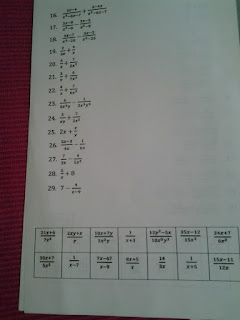I love introducing this unit using Sam Shah's Introduction to Rationals, basically every day of teaching it I pace around like a mad woman (more than usual) getting progressively more and more excited as time goes on. At least it adds a little theatrics to what could otherwise feel pretty dry and boring. I felt like I truly understood rationals the first time I worked through his introductions myself.
So we spend a couple days on that (I just briefly touch on slant asymptotes since I'm not required to do that yet, but I of course freak out over how we can find them easily using...the Box - yes I need a 12 step program for this obsession).
We then take off with
Graphs of Rationals:
I just wrote out my own notes this semester because I didn't like the ones I used before and we got to the graphing part before I typed any up. We did some basic graph practice - honestly, I have no idea where I got that worksheet.
The right hand page they do a sorting activity with VA and HA. I got it from TPT (gasp) back in my first year of teaching.
Multiply/Dividing Rationals
Some basic notes
Then they did a showdown activity where first they had to sort whether the problem was multiplication or division.
Adding/Subtracting Rationals
Some more basic notes
A basic matching activity
And then adding/subtracting speed dating!
Solving Rationals
Then we lose our minds when we get to solving. Next time I will type up these notes. Copying the equations takes 10 years.
I split up practice over two days. After notes they did this simple matching worksheet. Then they did a solving Around the World activity. Yay for finding what you are looking for and not having to make it yourself.
Solving Radicals
Then we randomly talk about radical equations because hey, why not?
I've got some lovely guided notes for you.
Then I spontaneously decided to do a different kind of practice with cards I had made before for speed dating. I color coded them (duh) green for easy/entry level, yellow for moderate and red for challenging. Students self-assessed where they were and then worked on problems in that group, moving up or down as necessary. I was completely shocked that I ended up needing several more of the hardest problems because students really grasped the concept and wanted to push themselves. They got very into the activity and I want to try incorporating it more somewhere else. I pulled problems from several locations for the activity and don't have a doc for them =/ sorry.
Unit resources link:





























No comments:
Post a Comment